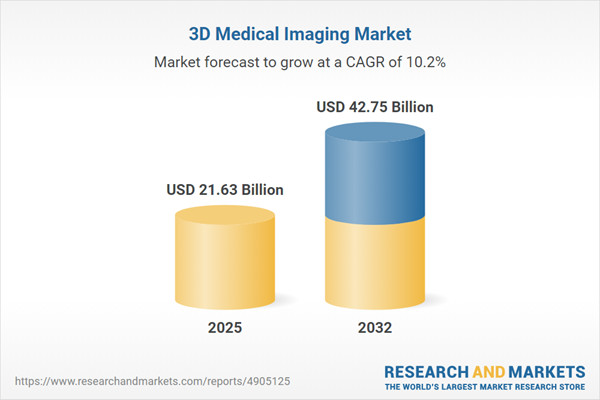Speak directly to the analyst to clarify any post sales queries you may have.
The global 3D medical imaging market is undergoing rapid transformation, driven by technology innovation, evolving clinical needs, and increasing demand for advanced diagnostics. Senior healthcare leaders should understand the market’s current dynamics, future direction, and strategic implications to inform effective decision-making and maintain a competitive edge.
Market Snapshot: 3D Medical Imaging Market Size and CAGR
The 3D medical imaging market grew from USD 19.64 billion in 2024 to USD 21.63 billion in 2025, with expectations of achieving a CAGR of 10.20% and reaching USD 42.75 billion by 2032. This robust expansion underscores the increasing adoption of three-dimensional visualization solutions in diagnostic and therapeutic settings. Growth is further bolstered by sophisticated vendor offerings, regulatory streamlining, and heightened emphasis on patient-centric care. The accelerating pace of hardware and software advancements continues to reshape how medical images are captured, processed, and used clinically, reinforcing the importance of this market across global regions.
Scope & Segmentation: Broad Applications and Detailed Market Coverage
This comprehensive report covers major segments and provides valuable insight into the depth and breadth of the 3D medical imaging landscape, including diverse end users, applications, product types, and regional trends.
- Product Types: Services (installation, maintenance, training); Software (analysis, integration, visualization); Systems (CT, MRI, PET, SPECT, ultrasound).
- Applications: Cardiology (blood flow analysis, cardiac imaging); Dentistry (dental implant planning, oral surgery); Neurology (brain mapping, neurodegenerative analysis); Oncology (treatment planning, tumor detection); Orthopedics (bone density analysis, joint imaging).
- End Users: Ambulatory care centers (outpatient clinics, specialty care centers); Diagnostic imaging centers (hospital-based, independent); Hospitals (private, public); Research institutes (academic, pharmaceutical labs).
- Regions: Americas (North America: United States, Canada, Mexico; Latin America: Brazil, Argentina, Chile, Colombia, Peru); Europe, Middle East & Africa (Europe: United Kingdom, Germany, France, Russia, Italy, Spain, Netherlands, Sweden, Poland, Switzerland; Middle East: United Arab Emirates, Saudi Arabia, Qatar, Turkey, Israel; Africa: South Africa, Nigeria, Egypt, Kenya); Asia-Pacific (China, India, Japan, Australia, South Korea, Indonesia, Thailand, Malaysia, Singapore, Taiwan).
- Leading Companies: Siemens Healthineers AG, GE HealthCare Technologies Inc., Koninklijke Philips N.V., Canon Medical Systems Corporation, Fujifilm Holdings Corporation, Hitachi Ltd., Samsung Medison Co. Ltd., Hologic Inc., Carestream Health Inc., Konica Minolta Inc.
Key Takeaways: Strategic Insights for Industry Leaders
- The integration of advanced AI-driven image reconstruction and analysis enables radiologists and clinicians to identify subtle anomalies, thereby supporting more precise and efficient diagnostic decisions.
- Collaborative ecosystems built on interoperable platforms and standardized data continue to facilitate cross-institutional research and telehealth, broadening access to expert imaging insights.
- Market competitiveness is increasingly shaped by partnerships between established manufacturers, academic centers, and agile technology startups, allowing the development of specialized or next-generation imaging solutions tailored to diverse healthcare needs.
- Providers are investing in personalized care tools, making volumetric visualization essential for treatment planning in complex specialties like oncology, neurology, and cardiology, and driving market relevance across all geographies.
- Segment-specific strategies, such as leveraging advanced imaging in outpatient care for streamlined workflows or supporting drug development in research institutes, are unlocking new value pools.
Tariff Impact: Navigating Regulatory Shifts in the Supply Chain
Recent changes in United States tariff policies have increased the cost of imported 3D imaging components and finished systems. This has prompted equipment suppliers to pursue near-shoring and local manufacturing initiatives to enhance supply chain resilience. As a result, healthcare providers may face pricing pressures, while manufacturers and service companies reconsider strategic sourcing and compliance models. These shifts are influencing both immediate procurement decisions and long-term innovation trajectories.
Methodology & Data Sources
This report employs a rigorous, multi-layered research methodology, including extensive secondary research, peer-reviewed sources, and regulatory filings. Primary interviews with healthcare providers, manufacturers, and policy experts ensure qualitative depth and expert validation. Triangulated data analysis and scenario planning offer reliable, actionable perspectives for senior leaders evaluating market trends and investment priorities.
Why This Report Matters
- Enables strategic planning and investment by providing clear segmentation and insights into emerging technologies and regional dynamics.
- Assists leadership in anticipating regulatory and supply chain shifts, supporting operational resilience and competitive positioning.
- Informs technology adoption and procurement strategies to maximize return on imaging investments across multiple clinical specialties.
Conclusion
The 3D medical imaging market continues to evolve, shaped by innovation, regional expansion, and regulatory adaptation. Executives who leverage the insights presented here are well-positioned to navigate complexity, optimize investments, and ensure sustainable growth.
Additional Product Information:
- Purchase of this report includes 1 year online access with quarterly updates.
- This report can be updated on request. Please contact our Customer Experience team using the Ask a Question widget on our website.
Table of Contents
3. Executive Summary
4. Market Overview
7. Cumulative Impact of Artificial Intelligence 2025
Companies Mentioned
The companies profiled in this 3D Medical Imaging market report include:- Siemens Healthineers AG
- GE HealthCare Technologies Inc.
- Koninklijke Philips N.V.
- Canon Medical Systems Corporation
- Fujifilm Holdings Corporation
- Hitachi, Ltd.
- Samsung Medison Co., Ltd.
- Hologic, Inc.
- Carestream Health, Inc.
- Konica Minolta, Inc.
Table Information
| Report Attribute | Details |
|---|---|
| No. of Pages | 199 |
| Published | October 2025 |
| Forecast Period | 2025 - 2032 |
| Estimated Market Value ( USD | $ 21.63 Billion |
| Forecasted Market Value ( USD | $ 42.75 Billion |
| Compound Annual Growth Rate | 10.2% |
| Regions Covered | Global |
| No. of Companies Mentioned | 11 |









